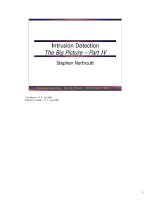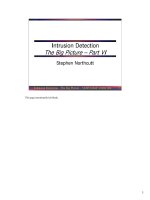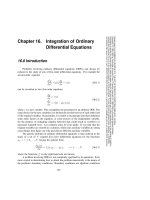Tài liệu Integration of Ordinary Differential Equations part 8 pdf
Bạn đang xem bản rút gọn của tài liệu. Xem và tải ngay bản đầy đủ của tài liệu tại đây (137.04 KB, 6 trang )
16.7 Multistep, Multivalue, and Predictor-Corrector Methods
747
Sample page from NUMERICAL RECIPES IN C: THE ART OF SCIENTIFIC COMPUTING (ISBN 0-521-43108-5)
Copyright (C) 1988-1992 by Cambridge University Press.Programs Copyright (C) 1988-1992 by Numerical Recipes Software.
Permission is granted for internet users to make one paper copy for their own personal use. Further reproduction, or any copying of machine-
readable files (including this one) to any servercomputer, is strictly prohibited. To order Numerical Recipes books,diskettes, or CDROMs
visit website or call 1-800-872-7423 (North America only),or send email to (outside North America).
free_vector(ysav,1,nv);
free_vector(yerr,1,nv);
free_vector(x,1,KMAXX);
free_vector(err,1,KMAXX);
free_matrix(dfdy,1,nv,1,nv);
free_vector(dfdx,1,nv);
free_matrix(d,1,nv,1,KMAXX);
}
The routine stifbs is an excellent routine for all stiff problems, competitive with
the best Gear-type routines. stiff is comparable in execution time for moderate N and
<
∼
10
−4
. By the time ∼ 10
−8
, stifbs is roughly an order of magnitude faster. There
are further improvements that could be applied to stifbs to make it even more robust. For
example, very occasionally ludcmp in simpr will encounter a singular matrix. You could
arrange for the stepsize to be reduced, say by a factor of the current nseq[k].Thereare
also certain stability restrictions on the stepsize that come into play on some problems. For
a discussion of how to implement these automatically, see
[6]
.
CITED REFERENCES AND FURTHER READING:
Gear, C.W. 1971,
Numerical Initial Value Problems in Ordinary Differential Equations
(Englewood
Cliffs, NJ: Prentice-Hall). [1]
Kaps, P., and Rentrop, P. 1979,
Numerische Mathematik
, vol. 33, pp. 55–68. [2]
Shampine, L.F. 1982,
ACM Transactions on Mathematical Software
, vol. 8, pp. 93–113. [3]
Enright, W.H., and Pryce, J.D. 1987,
ACM Transactions on Mathematical Software
, vol. 13,
pp. 1–27. [4]
Bader, G., and Deuflhard, P. 1983,
Numerische Mathematik
, vol. 41, pp. 373–398. [5]
Deuflhard, P. 1983,
Numerische Mathematik
, vol. 41, pp. 399–422.
Deuflhard, P. 1985,
SIAM Review
, vol. 27, pp. 505–535.
Deuflhard, P. 1987, “Uniqueness Theorems for Stiff ODE Initial Value Problems,”
Preprint SC-
87-3
(Berlin: Konrad Zuse Zentrum f¨ur Informationstechnik). [6]
Enright, W.H., Hull, T.E., and Lindberg, B. 1975,
BIT
, vol. 15, pp. 10–48.
Wanner, G. 1988, in
Numerical Analysis 1987
, Pitman Research Notes in Mathematics, vol. 170,
D.F. Griffiths and G.A. Watson, eds. (Harlow, Essex, U.K.: Longman Scientific and Tech-
nical).
Stoer, J., and Bulirsch, R. 1980,
Introduction to Numerical Analysis
(New York: Springer-Verlag).
16.7 Multistep, Multivalue, and
Predictor-Corrector Methods
Theterms multistepandmultivaluedescribetwodifferentways ofimplementing
essentially the same integration technique for ODEs. Predictor-corrector is a partic-
ular subcategrory of these methods — in fact, the most widely used. Accordingly,
the name predictor-corrector is often loosely used to denote all these methods.
We suspect that predictor-corrector integrators have had their day, and that they
are no longer the method of choice for most problems in ODEs. For high-precision
applications, or applicationswhere evaluations of the right-handsides are expensive,
Bulirsch-Stoer dominates. For convenience, or for low precision, adaptive-stepsize
Runge-Kuttadominates. Predictor-corrector methods have been, we think, squeezed
748
Chapter 16. Integration of Ordinary Differential Equations
Sample page from NUMERICAL RECIPES IN C: THE ART OF SCIENTIFIC COMPUTING (ISBN 0-521-43108-5)
Copyright (C) 1988-1992 by Cambridge University Press.Programs Copyright (C) 1988-1992 by Numerical Recipes Software.
Permission is granted for internet users to make one paper copy for their own personal use. Further reproduction, or any copying of machine-
readable files (including this one) to any servercomputer, is strictly prohibited. To order Numerical Recipes books,diskettes, or CDROMs
visit website or call 1-800-872-7423 (North America only),or send email to (outside North America).
out in the middle. There is possibly only one exceptional case: high-precision
solution of very smooth equations with very complicated right-hand sides, as we
will describe later.
Nevertheless, these methods have had a long historical run. Textbooks are
full of information on them, and there are a lot of standard ODE programs around
that are based on predictor-corrector methods. Many capable researchers have a
lot of experience with predictor-corrector routines, and they see no reason to make
a precipitous change of habit. It is not a bad idea for you to be familiar with the
principles involved, and even with the sorts of bookkeeping details that are the bane
of these methods. Otherwise there will be a big surprise in store when you first have
to fix a problem in a predictor-corrector routine.
Let us first consider the multistep approach. Think about how integrating an
ODE is different from findingthe integral of a function: For a function,the integrand
has a known dependence on the independent variable x, and can be evaluated at
will. For an ODE, the “integrand” is the right-hand side, which depends both on
x and on the dependent variables y. Thus to advance the solution of y
= f(x, y)
from x
n
to x,wehave
y(x)=y
n
+
x
x
n
f(x
,y)dx
(16.7.1)
In a single-step method like Runge-Kutta or Bulirsch-Stoer, the value y
n+1
at x
n+1
depends only on y
n
. In a multistep method, we approximate f(x, y) by a polynomial
passing through several previous points x
n
,x
n−1
,... and possibly also through
x
n+1
. The result of evaluating the integral (16.7.1) at x = x
n+1
is then of the form
y
n+1
= y
n
+ h(β
0
y
n+1
+ β
1
y
n
+ β
2
y
n−1
+ β
3
y
n−2
+ ···)(16.7.2)
where y
n
denotes f(x
n
,y
n
), and so on. If β
0
=0, the method is explicit; otherwise
it is implicit. The order of the method depends on how many previous steps we
use to get each new value of y.
Consider how we might solve an implicitformula of the form (16.7.2) for y
n+1
.
Two methods suggest themselves: functional iteration and Newton’s method.In
functional iteration, we take some initial guess for y
n+1
, insert it into the right-hand
side of (16.7.2) to get an updated value of y
n+1
, insert this updated value back into
the right-hand side, and continue iterating. But how are we to get an initial guess for
y
n+1
? Easy! Just use some explicit formula of the same form as (16.7.2). This is
called the predictor step. In the predictor step we are essentially extrapolating the
polynomial fit to the derivative from the previous points to the new point x
n+1
and
then doing the integral (16.7.1) in a Simpson-like manner from x
n
to x
n+1
.The
subsequent Simpson-like integration, using the prediction step’s value of y
n+1
to
interpolate the derivative, is called the corrector step. The difference between the
predicted and corrected function values supplies information on the local truncation
error that can be used to control accuracy and to adjust stepsize.
If one corrector step is good, aren’t many better? Why not use each corrector
as an improved predictor and iterate to convergence on each step? Answer: Even if
you had a perfect predictor, the step would still be accurate only to the finite order
of the corrector. This incurable error term is on the same order as that which your
iteration is supposed to cure, so you are at best changing only the coefficient in front
16.7 Multistep, Multivalue, and Predictor-Corrector Methods
749
Sample page from NUMERICAL RECIPES IN C: THE ART OF SCIENTIFIC COMPUTING (ISBN 0-521-43108-5)
Copyright (C) 1988-1992 by Cambridge University Press.Programs Copyright (C) 1988-1992 by Numerical Recipes Software.
Permission is granted for internet users to make one paper copy for their own personal use. Further reproduction, or any copying of machine-
readable files (including this one) to any servercomputer, is strictly prohibited. To order Numerical Recipes books,diskettes, or CDROMs
visit website or call 1-800-872-7423 (North America only),or send email to (outside North America).
of the error term by a fractional amount. So dubious an improvement is certainly not
worth the effort. Your extra effort would be better spent in taking a smaller stepsize.
As described so far, you might think it desirable or necessary to predict several
intervals ahead at each step, then to use all these intervals, with various weights, in
a Simpson-like corrector step. That is not a good idea. Extrapolation is the least
stable part of the procedure, and it is desirable to minimize its effect. Therefore, the
integration steps of a predictor-corrector method are overlapping, each one involving
several stepsize intervals h, but extending just one such interval farther than the
previous ones. Only that one extended interval is extrapolated by each predictor step.
The most popular predictor-corrector methods are probably the Adams-
Bashforth-Moulton schemes, which have good stability properties. The Adams-
Bashforth part is the predictor. For example, the third-order case is
predictor: y
n+1
= y
n
+
h
12
(23y
n
− 16y
n−1
+5y
n−2
)+O(h
4
)(16.7.3)
Here information at the current point x
n
, together with the two previous points x
n−1
and x
n−2
(assumed equally spaced), is used to predict the value y
n+1
at the next
point, x
n+1
. The Adams-Moulton part is the corrector. The third-order case is
corrector: y
n+1
= y
n
+
h
12
(5y
n+1
+8y
n
−y
n−1
)+O(h
4
)(16.7.4)
Without the trial value of y
n+1
from the predictor step to insert on the right-hand
side, the corrector would be a nasty implicit equation for y
n+1
.
There are actually three separate processes occurring in a predictor-corrector
method: the predictor step, which we call P, the evaluation of the derivative y
n+1
from the latest value of y, which we call E, and the corrector step, which we call
C. In this notation, iterating m times with the corrector (a practice we inveighed
against earlier) would be written P(EC)
m
. One also has the choice of finishing with
a C or an E step. The lore is that a final E is superior, so the strategy usually
recommended is PECE.
Notice that a PC method with a fixed number of iterations (say, one) is an
explicit method! When we fix the number of iterations in advance, then the final
valueof y
n+1
can be writtenas somecomplicated functionofknownquantities. Thus
fixed iteration PC methods lose the strong stability properties of implicit methods
and should only be used for nonstiff problems.
For stiff problems we must use an implicit method if we want to avoid having
tiny stepsizes. (Not all implicit methods are good for stiff problems, but fortunately
some good ones such as the Gear formulas are known.) We then appear to have two
choices for solving the implicit equations: functional iteration to convergence, or
Newton iteration. However, it turns out that for stiff problems functional iteration
will not even converge unless we use tiny stepsizes, no matter how close our
prediction is! Thus Newton iteration is usually an essential part of a multistep
stiff solver. For convergence, Newton’s method doesn’t particularly care what the
stepsize is, as long as the prediction is accurate enough.
Multistep methods, as we have described them so far, suffer from two serious
difficulties when one tries to implement them:
• Since the formulas require results from equally spaced steps, adjusting
the stepsize is difficult.
750
Chapter 16. Integration of Ordinary Differential Equations
Sample page from NUMERICAL RECIPES IN C: THE ART OF SCIENTIFIC COMPUTING (ISBN 0-521-43108-5)
Copyright (C) 1988-1992 by Cambridge University Press.Programs Copyright (C) 1988-1992 by Numerical Recipes Software.
Permission is granted for internet users to make one paper copy for their own personal use. Further reproduction, or any copying of machine-
readable files (including this one) to any servercomputer, is strictly prohibited. To order Numerical Recipes books,diskettes, or CDROMs
visit website or call 1-800-872-7423 (North America only),or send email to (outside North America).
• Starting and stopping present problems. For starting, we need the initial
values plus several previous steps to prime the pump. Stopping is a
problem because equal steps are unlikely to land directly on the desired
termination point.
Older implementations of PC methods have various cumbersome ways of
dealing with these problems. For example, they might use Runge-Kutta to start
and stop. Changing the stepsize requires considerable bookkeeping to do some
kind of interpolation procedure. Fortunately both these drawbacks disappear with
the multivalue approach.
For multivalue methods the basic data available to the integrator are the first
few terms of the Taylor series expansion of the solution at the current point x
n
.The
aim is to advance the solution and obtain the expansion coefficients at the next point
x
n+1
. This is in contrast to multistep methods, where the data are the values of
the solution at x
n
,x
n−1
,.... We’ll illustrate the idea by considering a four-value
method, for which the basic data are
y
n
≡
y
n
hy
n
(h
2
/2)y
n
(h
3
/6)y
n
(16.7.5)
It is also conventional to scale the derivatives with the powers of h = x
n+1
− x
n
as shown. Note that here we use the vector notation y to denote the solution and
its first few derivatives at a point, not the fact that we are solving a system of
equations with many components y.
In terms of the data in (16.7.5), we can approximate the value of the solution
y at some point x:
y(x)=y
n
+(x−x
n
)y
n
+
(x−x
n
)
2
2
y
n
+
(x − x
n
)
3
6
y
n
(16.7.6)
Set x = x
n+1
in equation (16.7.6) to get an approximation to y
n+1
. Differentiate
equation (16.7.6) andset x = x
n+1
to get an approximationto y
n+1
, andsimilarlyfor
y
n+1
and y
n+1
. Call the resulting approximation
y
n+1
, where the tilde is a reminder
that all we have done so far is a polynomial extrapolation of the solution and its
derivatives; we have not yet used the differential equation. You can easily verify that
y
n+1
= B · y
n
(16.7.7)
where the matrix B is
B =
1111
0123
0013
0001
(16.7.8)
We now write the actual approximation to y
n+1
that we will use by adding a
correction to
y
n+1
:
y
n+1
=
y
n+1
+ αr (16.7.9)
16.7 Multistep, Multivalue, and Predictor-Corrector Methods
751
Sample page from NUMERICAL RECIPES IN C: THE ART OF SCIENTIFIC COMPUTING (ISBN 0-521-43108-5)
Copyright (C) 1988-1992 by Cambridge University Press.Programs Copyright (C) 1988-1992 by Numerical Recipes Software.
Permission is granted for internet users to make one paper copy for their own personal use. Further reproduction, or any copying of machine-
readable files (including this one) to any servercomputer, is strictly prohibited. To order Numerical Recipes books,diskettes, or CDROMs
visit website or call 1-800-872-7423 (North America only),or send email to (outside North America).
Here r will be a fixed vector of numbers, in the same way that B is a fixed matrix.
We fix α by requiring that the differential equation
y
n+1
= f(x
n+1
,y
n+1
)(16.7.10)
be satisfied. The second of the equations in (16.7.9) is
hy
n+1
= hy
n+1
+ αr
2
(16.7.11)
and this will be consistent with (16.7.10) provided
r
2
=1,α=hf(x
n+1
,y
n+1
) − hy
n+1
(16.7.12)
The values of r
1
, r
3
,andr
4
are free for the inventor of a given four-value method to
choose. Different choices give different orders of method (i.e., through what order
in h the final expression 16.7.9 actually approximates the solution), and different
stability properties.
An interesting result, not obvious from our presentation, is that multivalue and
multistep methods are entirely equivalent. In other words, the value y
n+1
given by
a multivalue method with given B and r is exactly the same value given by some
multistep method with given β’s in equation (16.7.2). For example, it turns out
that the Adams-Bashforth formula (16.7.3) corresponds to a four-value method with
r
1
=0,r
3
=3/4,andr
4
=1/6. The method is explicit because r
1
=0.The
Adams-Moultonmethod (16.7.4) corresponds to the implicit four-value method with
r
1
=5/12, r
3
=3/4,andr
4
=1/6. Implicit multivalue methods are solved the
same way as implicit multistep methods: either by a predictor-corrector approach
using an explicit method for the predictor, or by Newton iteration for stiff systems.
Why go to all the trouble of introducing a whole new method that turns out
to be equivalent to a method you already knew? The reason is that multivalue
methods allow an easy solution to the two difficulties we mentioned above in
actually implementing multistep methods.
Consider first the question of stepsize adjustment. To change stepsize from h
to h
at some point x
n
, simply multiply the components of y
n
in (16.7.5) by the
appropriate powers of h
/h, and you are ready to continue to x
n
+ h
.
Multivalue methods also allow a relatively easy change in the order of the
method: Simply change r. The usual strategy for this is first to determine the new
stepsize with the current order from the error estimate. Then check what stepsize
would be predicted using an order one greater and one smaller than the current
order. Choose the order that allows you to take the biggest next step. Being able to
change order also allows an easy solution to the starting problem: Simply start with
a first-order method and let the order automatically increase to the appropriate level.
For low accuracy requirements, a Runge-Kutta routine like rkqs is almost
always the most efficient choice. For high accuracy, bsstep is both robust and
efficient. For very smooth functions, a variable-order PC method can invoke very
high orders. If the right-hand side of the equation is relatively complicated, so that
the expense of evaluating it outweighs the bookkeeping expense, then the best PC
packages can outperform Bulirsch-Stoer on such problems. As you can imagine,
however, such a variable-stepsize, variable-order method is not trivial to program. If









